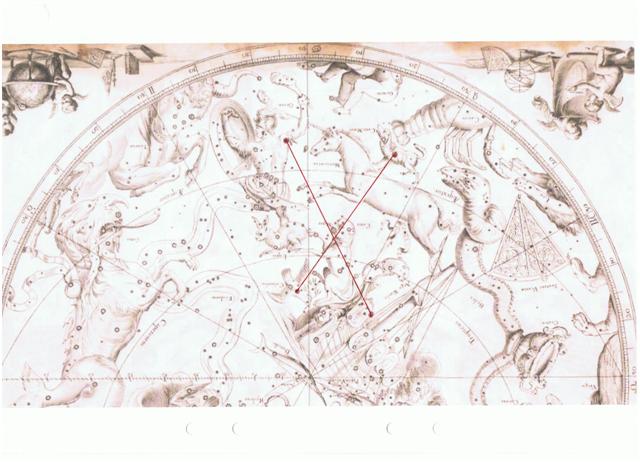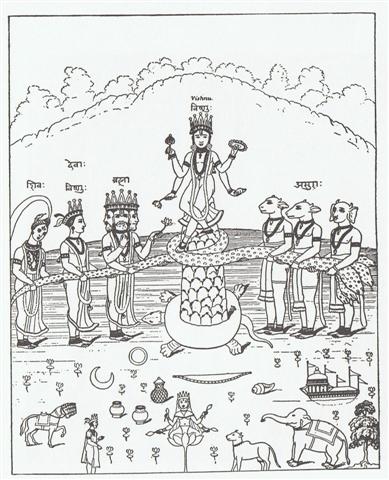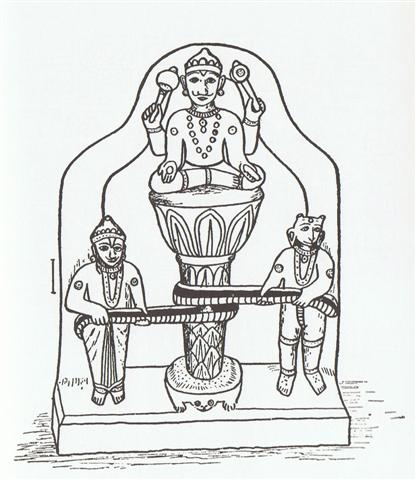The parallel glyph in the P
text confirms that Ha6-28 indeed should be the bottom half of
the Egyptian X type of glyph:
 |
 |
 |
 |
 |
|
Ha6-25 |
Ha6-26 |
Ha6-27 |
Ha6-28 (308) |
Ha6-29 |
 |
 |
 |
 |
|
Pa5-69 |
Pa5-70 |
Pa5-71 |
Pa5-72 (307) |

|
LARGE
ST PETERSBURG (P) |
|
a1 |
53 |
53 |
b1 |
25 |
25 |
|
a2 |
59 |
112 |
b2 |
36 |
61 |
|
a3 |
62 |
174 |
b3 |
39 |
100 |
|
a4 |
61 |
235 |
b4 |
56 |
156 |
|
a5 |
80 |
315 |
b5 |
50 |
206 |
|
a6 |
60 |
375 |
b6 |
59 |
265 |
|
a7 |
58 |
433 |
b7 |
63 |
328 |
|
a8 |
55 |
488 |
b8 |
65 |
393 |
|
a9 |
42 |
530 |
b9 |
50 |
443 |
|
a10 |
36 |
566 |
b10 |
56 |
499 |
|
a11 |
33 |
599 |
b11 |
*61 |
*560 |
|
sum |
599 |
sum |
560 |
|
19 * 61 =
1159 |
|

 |
The left (Egyptian X) part of Pa5-72 is
held by the right arm of the man in front,
demonstrating that it is a single glyph, in contrast
to how
the corresponding headless figure in Ha6-29 has its arm
hanging down, which means it is a separate entity.
The structure is similar but the
meaning is not the same.
The creator of the Q text (which runs in parallel
with the H and P texts) may have been forced to
exclude some parts of the story because his tablet
could not carry so many glyphs.
|
SMALL
ST PETERSBURG (Q) |
|
a1 |
*23? |
23 |
b1 |
51 |
51 |
|
a2 |
43 |
66 |
b2 |
46 |
97 |
|
a3 |
41 |
107 |
b3 |
*51? |
148 |
|
a4 |
*43? |
150 |
b4 |
*39? |
187 |
|
a5 |
55 |
205 |
b5 |
*42? |
229 |
|
a6 |
*49? |
254 |
b6 |
*33? |
262 |
|
a7 |
*41? |
295 |
b7 |
*39? |
301 |
|
a8 |
47 |
342 |
b8 |
32 |
333 |
|
a9 |
45 |
387 |
b9 |
*12? |
345 |
|
sum |
*387 (?) |
sum |
*345 (?) |
|
3 * 129 +
3 * 115 =
12 * 61
= 4 * 183 |
|


|
The last glyph in line Qa5 lines up nicely with
Ha6-6 respectively with Pa5-52, but then the
following
glyph - the first one in line Qa6 - lines up with Ha6-38 respectively
with Pa5-79:
 |
21 |
 |
9 |
 |
|
Ha6-6
(286) |
Ha6-28 (308) |
Ha6-38 (318 = 288 + 30) |
 |
19 |
 |
6 |
 |
|
Pa5-52 (287) |
Pa5-72 (307) |
Pa5-79 (314 = 288 + 26) |
 |
EGYPTIAN X |
 |
|
Qa5-55 (205 = 286 - 81) |
Qa6-1
(206 = 288 - 82) |
31 days appear to be absent in the Q text if compared to the H text,
but only 26 days if compared to the P text.
However, 31 - 26 = 5 glyphs correspond to the
burnt area in line Ha6. These 5 days could
evidently have been used in order to illustrate the
apex (noon), where the change from above (male)
to below (female) occurs:
... When this tremendous task
had been accomplished Atea took a third
husband, Fa'a-hotu, Make Fruitful. Then
occurred a curious event. Whether Atea
had wearied of bringing forth offspring we are
not told, but certain it is that Atea and
her husband Fa'a-hotu exchanged sexes.
Then the [male] eyes of Atea glanced down
at those of his wife
Hotu
and they begat Ru. It was this Ru
who explored the whole earth and divided it into
north, south, east, and west
...
 |
 |
 |
 |
 |
|
Ha6-15 |
Ha6-16 |
Ha6-17 |
Ha6-18 |
Ha6-19 |
|
BURNT AREA |
|
*Ha6-20 |
*Ha6-21 |
*Ha6-22 |
*Ha6-23 |
*Ha6-24 |
 |
 |
 |
 |
 |
|
*Ha6-25 |
*Ha6-26 |
*Ha6-27 |
*Ha6-28 |
*Ha6-29 |
... Nut, whom
the Greeks sometimes identified
with Rhea, was goddess of the
sky, but it was debatable if in
historical times she was the
object of a genuine cult. She
was Geb's twin sister and, it
was said, married him secretly
and against the will of Ra.
Angered, Ra had the couple
brutally separated by Shu and
afterwards decreed that Nut
could not bear a child in any
given month of any year. Thoth,
Plutarch tells us, happily had
pity on her. Playing draughts
with the Moon, he won in the
course of several games a
seventy-second part of the
Moon's light with which he
composed five new days. As these
five intercalated days did not
belong to the official Egyptian
calendar of three hundred and
sixty days, Nut was thus able to
give birth successively to five
children: Osiris, Haroeris
(Horus), Set, Isis and Nepthys
...
|
BET-EL-GEUZE |
α Orionis |
0.58 |
07° 24′ N |
88.3 |
June 17 |
168 = 13 + 11 weeks |
|
CANOPUS |
α Carinae |
-0.72 |
52° 40′ S |
95.6 |
June 24 |
175 = 25 weeks |
|
5 days |
|
SIRIUS |
α Canis Majoris |
-1.46 |
16° 39′ S |
101.2 |
June 30 |
181 (= 175 + 6) |
|
DRUS |
χ Carinae
|
3.46 |
52° 59′ S |
119.9 |
July 18
|
199 (= 168 +
31) |
|
NAOS |
ζ Puppis |
2.21 |
39° 52′ S |
121.3 |
July 20 |
201 (= 175
+
26) |
I think the creator of the Q text would have
thought a lot about how to use the limited area
of his tablet. It might be significant
that the beginning of his line a6 was at a glyph
number which was 26 + 82 = 108 less than the
number of the corresponding glyph in the P text.
Because 108 might be explained as for instance
the difference between 364 (= 4 * 91) and 472 (=
1½ * 314 + 1 = 4 * 118).
| ... It is
known that in the final battle of
the gods, the massed legions on the
side of 'order' are the dead
warriors, the 'Einherier' who once
fell in combat on earth and who have
been transferred by the Valkyries to
reside with Odin in Valhalla - a
theme much rehearsed in heroic
poetry. On the last day, they issue
forth to battle in martial array.
Says Grimnismal (23): 'Five
hundred gates and forty more - are
in the mighty building of Walhalla -
eight hundred 'Einherier' come out
of each one gate - on the time they
go out on defence against the Wolf.'
That makes 432,000 in all, a number
of significance from of old. This
number must have had a very ancient
meaning, for it is also the number
of syllables in the Rigveda.
But it goes back to the basic figure
10,800, the number of stanzas in the
Rigveda (40 syllables to a
stanza) which, together with 108,
occurs insistently in Indian
tradition, 10,800 is also the number
which has been given by Heraclitus
for the duration of the Aiōn,
according to Censorinus (De die
natali, 18), whereas Berossos
made the Babylonian Great Year to
last 432,000 years. Again, 10,800 is
the number of bricks of the Indian
fire-altar (Agnicayana).32
32
See J. Filliozat, 'L'Indie et les
échanges scientifiques dans
l'antiquité', Cahiers d'histoire
mondiale 1 (1953), pp. 358f.
'To quibble
away such a coincidence', remarks
Schröder, 'or to ascribe it to
chance, is in my opinion to drive
skepticism beyond its limits.'33
33 F. R. Schröder,
Altgermanischer Kulturprobleme
(1929), pp. 80f.
Shall one add
Angkor to the list? It has five
gates, and to each of them leads a
road, bridging over that water ditch
which surrounds the whole place.
Each of these roads is bordered by a
row of huge stone figures, 108 per
avenue, 54 on each side, altogether
540 statues of Deva and Asura, and
each row carries a huge Naga serpent
with nine heads. Only, they do not
'carry' that serpent, they are shown
to 'pull' it, which indicates that
these 540 statues are churning the
Milky Ocean, represented (poorly,
indeed) by the water ditch,34
using Mount Mandara as a churning
staff, and Vasuki, the prince of the
Nagas, as their drilling rope.
34 R. von Heine-Geldern,
'Weltbild und Bauform in
Südostasien', in Wiener Beiträge zur
Kunst- und Kulturgeschichte 4
(1910), p. 15.
(Just to
prevent misunderstanding: Vasuki had
been asked before, and had agreeably
consented, and so had Vishnu's
tortoise avatar, who was going to
serve as the fixed base for that
'incomparably mighty churn', and
even the Milky Ocean itself had made
it clear that it was willing to be
churned.)

The 'incomparably mighty churn' of the Sea of Milk,
as described in the Mahabharata
and Ramayana. The heads of
the deities on the right are the
Asura, with unmistakable 'Typhonian'
characteristics. They stand for the
same power as the Titans, the
Turanians, and the people of Untamo,
is short, the 'family' of the bad
uncle, among whom Seth is the oldest
representative, pitted against
Horus, the avenger of his father
Osiris.

The simplified
version of the Amritamanthana (or
Churning of the Milky Ocean) still
shows Mount Mandara used as a pivot
or churning stick, resting on the
tortoise. And here, also, the head
on the right has 'Typhonian'
features. The whole of Angkor thus
turns out to be a colossal model set
up for 'alternative motion' with
true Hindu fantasy and
incongruousness to counter the idea
of a continuous one-way Precession
from west to east ... |
His fish-hook has (below) lost its point and in
the following glyph his
'hair-do' (above) has lost its finish. In between 26 glyphs
seem to have been
dis-carded.
... 'Who are you talking to?' said the
King, coming up to Alice, and looking at the
Cat's head with great curiosity. 'It's a friend
of mine - a Cheshire-Cat,' said Alice: 'allow me
to introduce it.'

'I don't like the look of it
at all,' said the King: 'however, it may kiss my
hand, if it likes.' 'I'd rather not,' the Cat
remarked. 'Don't be impertinent,' said the King,
'and don't look at me like that!' He got behind
Alice as he spoke. 'A cat may look at a king,'
said Alice. 'I've read that in some book, but I
don't remember where.' 'Well, it must be
removed,' said the King very decidedly: and he
called to the Queen, who was passing at the
moment, 'My dear! I wish you would have this cat
removed!' The Queen
had only one way of settling all difficulties,
great or small. 'Off with his head!' she said
without even looking around ...
In other words, it is possible that Qa6-1 was
82 days before October 15 (288) and that the
Q text was beginning with January 1.
|
 |
30 |
 |
81 |
 |
|
Qa5-55 (205) |
Qa6-1 (206) |
Qa7-34 (288) |
|
June 24 (175) |
July 25 (206) |
Oct 15 (288) |
|
CANOPUS |
AVIOR |
BENETNASH |
|
32 + 82 = 6 * 19 |
|
THE OAK HULL (BACKBONE) |
|
Canopus |
α |
365 |
52° 40′ S |
-0.72 |
95 |
|
Drus |
χ |
270 |
52° 59′ S |
3.46 |
zero |
|
Avior |
ε |
325 |
59º
31' S |
1.86 |
55 |
|
20 * 48 = 365 + 270 +
325 = 40 * 24
|
However, new land should be fished up at Eridu
(Canopus) - in the Day of Saint John - which was
in June 24 (175 = 350 / 2). In which case the Q text could
have its beginning already 30 days before
January 1.
366 - 30 = 336 (= 4 * 84 = 7 * 48) = 365 - 29 =
320 + 16 = 12 * 28.
... Anciently the winter months had only 29
days.
The Julian calendar introduced in 46 B.C. by Caesar changed the earlier 355 day long regular calendar by increasing the length of 7 of the months:
| Martius |
31 |
31 |
- |
| Aprilis |
29 |
30 |
+1 |
| Maius |
31 |
31 |
- |
| Iunius |
29 |
30 |
+1 |
| Quintilis |
31 |
31 |
- |
| Sextilis |
29 |
31 |
+2 |
| Sum |
180 |
184 |
+4 |
| Sept |
29 |
30 |
+1 |
| Oct |
31 |
31 |
- |
| Sum |
240 = 180 + 60 |
245 = 184 + 61 |
+5 |
| Nov |
29 |
115 |
30 |
+1 |
| Dec |
29 |
31 |
+2 |
| Ianuarius |
29 |
31 |
+2 |
| Februarius |
28 |
28 |
- |
| Sum |
355 = 240 + 115 |
365 = 245 + 120 |
+10 |
The ordinary year in the previous Roman calendar consisted of 12 months, for a total of 355 days. In addition, a 27-day intercalary month, the Mensis Intercalaris, was sometimes inserted between February and March. This intercalary month was formed by inserting 22 days after the first 23 or 24 days of February; the last five days of February, which counted down toward the start of March, became the last five days of Intercalaris. The net effect was to add 22 or 23 days to the year, forming an intercalary year of 377 or 378 days.
|
... The evening of 23 June,
St. John's Eve, is the eve of celebration before
the Feast Day of Saint John the Baptist. The
Gospel of Luke (Luke 1:36, 56-57) states that
John was born about six months before Jesus;
therefore, the feast of John the Baptist was
fixed on 24 June, six months before Christmas
Eve ...

|











